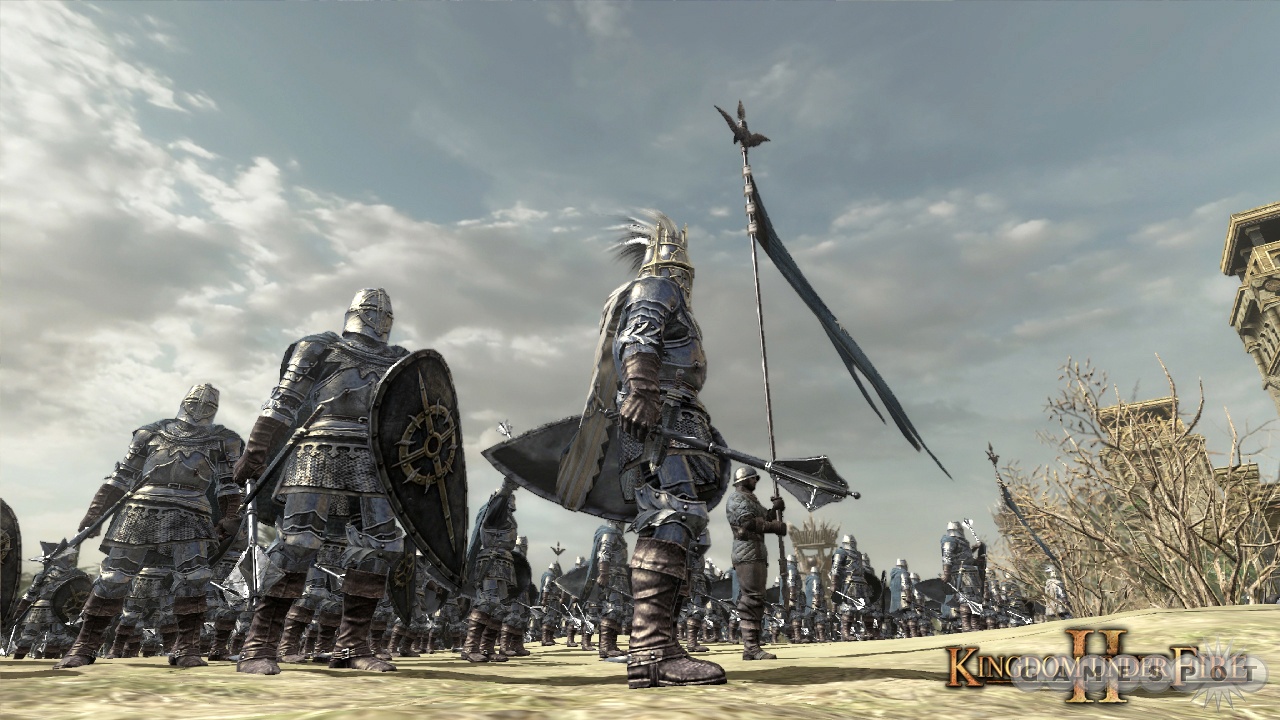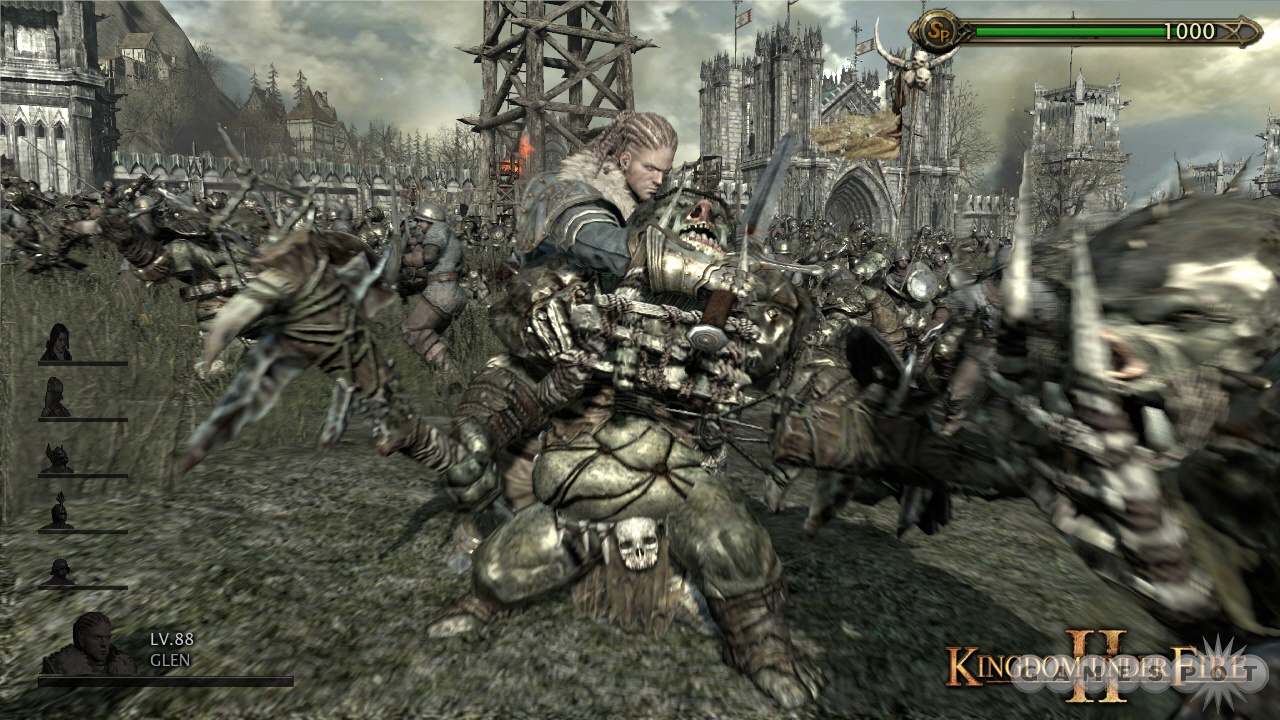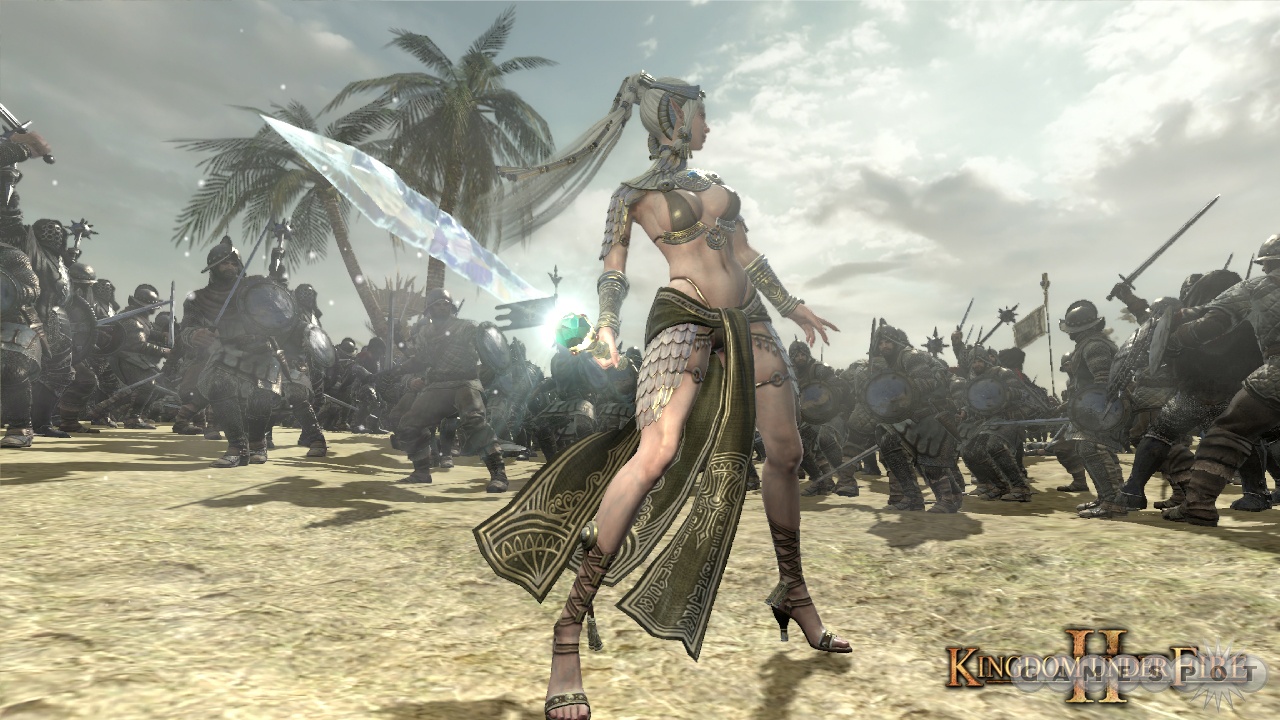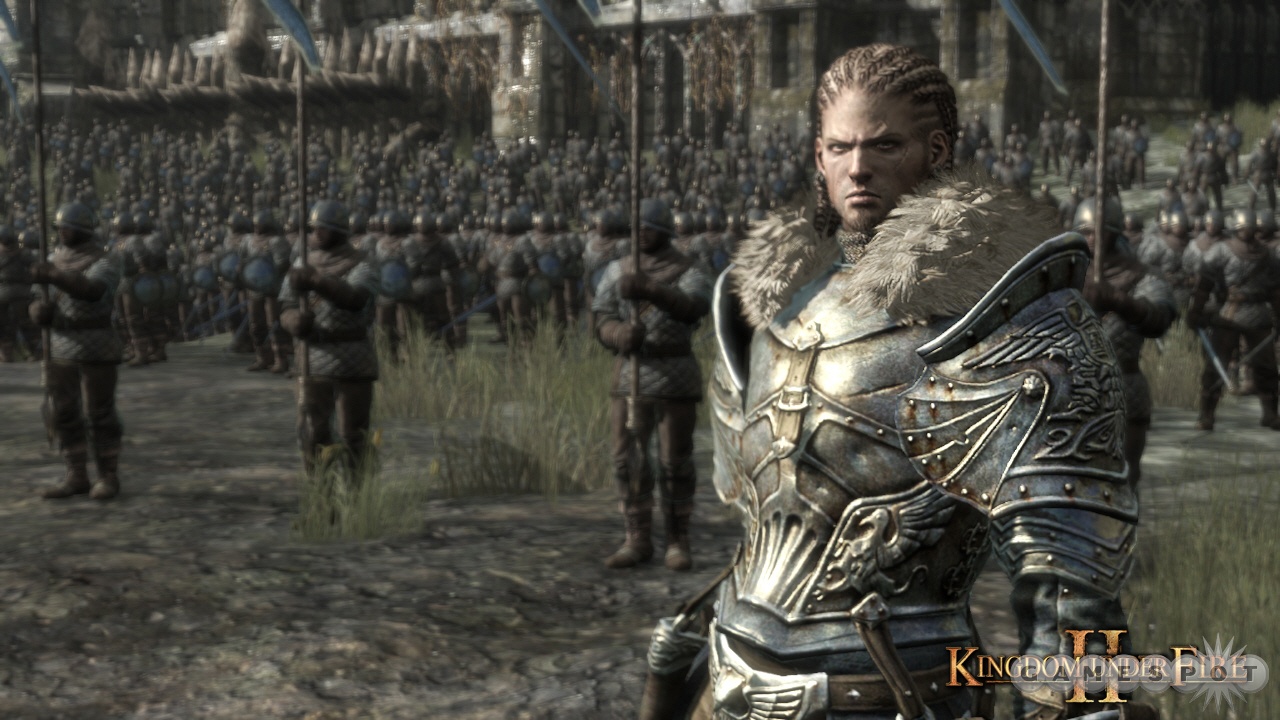Kingdom Under Fire II Q&A: Bringing Massively Multiplayer to RTS
The Kingdom Under Fire series is transforming again. Check out our Q&A with producer SangYoun Lee to see what changes are in store in KUFII.
No doubt about it: The Kingdom Under Fire series is always changing. After dabbling in action and role-playing elements in the traditionally real-time strategy series (even combining the two in the action-heavy Kingdom Under Fire: Circle of Doom), developers are bringing it back home and online with the RTS-focused Kingdom Under Fire II. Revolving around a concept they're dubbing MOARTS (multiplayer online action real-time strategy, naturally), the game looks to be well on its way to once again redefining the KUF series. To get a better handle on the game's new direction, we spoke with Blueside's executive producer and director, SangYoun Lee.

GameSpot: How did you decide which direction to go in for a new KUF? The series has gone in a few different directions now, so how did you decide which way to go this time?
SangYoun Lee: Kingdom Under Fire II is the true sequel to Kingdom Under Fire: The Crusaders. It is being developed with the goal to perfect the genre of action real-time strategy, which was first introduced in The Crusaders. In order to achieve that goal, the elements of action and strategy must be fused perfectly well. We've implemented many deep and sophisticated game mechanics, so that the action in Kingdom Under Fire II can go beyond just delivering the fun of hack and slash; the game is designed in a way such that the action can add to the aspect of strategy by being part of its tactical gameplay. Also, we believe that the real excitement and fun of strategy games can be enjoyed when you play them with other people. To create a game that can be enjoyed by a lot of people and for a long time, we are re-creating and enhancing the online multiplayer portion of the game, to be presented with battles of unprecedented scales.
GS: How much did player feedback on the last game affect development on KUFII?
SL: A lot of user feedbacks were taken into consideration in development of the game. After the release of Kingdom Under Fire: The Crusaders, many of those who played the game gave us lots of feedbacks, and we agreed with many of the points made in those feedbacks, and it helped us a great deal in making a better sequel. The tough learning curve of the game and the aspect of strategy being a little weak in online multiplayer were pointed out as things to be improved upon. And those improvements we've implemented in Kingdom Under Fire II. The steep learning curve is no more, and the new sequel will be more accessible than ever to all gamers. As for the multiplayer aspect, we've added a number of new concepts, such as "mothership," "providing support for troops," and "capturing of bases." The tactical aspect of gameplay, encouraging the players to exploit different geographical features of each battle map, which has already been introduced in Kingdom Under Fire: The Crusaders, will also be present in the new sequel as well, and with all tactical elements mentioned above or to be revealed, Kingdom Under Fire II is going to test your tactical battle skills more rigorously than all other strategy games. You will be introduced to battles with the most extensive scope of strategic choices.
GS: How does this game differ from previous KUF games?
SL: The Kingdom Under Fire series is well known for its deep tactical gameplay and the intense hack-and-slash action with heroes. Kingdom Under Fire II improves upon the predecessors by showcasing blockbuster-scale battles with thousands of units rendered in more realistic and detailed graphics, all appearing onscreen simultaneously. You'll have seen nothing like it. Every controllable hero and unit comes alive with more realistic movements than ever, and the game more than doubles the number of troops that can be put under your command, therefore expanding the scope of warfare tactics. On top of that, in addition to the Human Alliance and the Dark Legion, a new third race called Encablossians will be introduced, and players will be able to choose new heroes and dozens of strange and alien-like units. Your heroes and troops can become stronger in many ways through the all-new electronic card system. All these aspects of games are there for you to enjoy in an MMO world occupied by thousands of players, and gamers will be able to go head-to-head in a variety of multiplayer online modes, such as War, Skirmish, Ladder games, and Castle Siege mode.

GS: Will the game's story have any connection to any of the previous games? If so, where does it fit in? Will we see any familiar characters from the previous game?
SL: Kingdom Under Fire II is set 150 years after the end of Kingdom Under Fire: The Crusaders. The story picks up after The Crusaders and Circle of Doom. At the end of the plotline covered in Circle of Doom, Regnier and Kendal emerge back into the present world after much struggle to escape from the dark dimension of Encablossa. They find out that 150 years have passed since the Encablossa War, and the world has been ravaged by Encablossians, mutated creatures born of the taint of the dark power from Encablossa. This time, Kendal plays a very important role storywise. As for which heroes from the predecessors will make a comeback, or what kinds of new heroes will be introduced, we'll reveal more information one bit at a time in the coming days.
GS: What can you tell us about the gameplay in this new KUF? How are you going to get so many players together online and still keep the action fun and playable?
SL: Numerous players will be able to maintain their presence in the online continent of Bersia. There are going to be more than 10 thousand players registered in each server, and players will be able to travel around the online world in something called a "mothership." The persistent online world will be rendered in full 3D, and on it you will see numerous ships flying and exploring. There are many cities in this world, and soon everyone will be engaged in territorial conquests. There will be guilds and factions that you can join, and you will partake in the campaign of territorial expansion for your group. In many different geographical locations, many types of battles will take place, including multiplayer field match, online co-op missions, and the all-new castle siege battle. We are preparing different types and sizes of battlefields: small ones for two-vs.-two and three-vs.-three, or huge maps to accommodate possibly a maximum of 15-vs.-15. The number of troops that can be assigned to each player will be determined by the size and type of map where the battle is fought. Based on the result, each player will be rewarded with items, war funds, and experience points. These small field battles are what make up the big war over the whole continent, and this is how guilds and factions will function and get involved in territorial conquests.
GS: Why did you decide to aim for a whole new genre for this game? How challenging is it going to be technically?
SL: Action RTS is not at all new to us, because it was us who first created and established this genre with Kingdom Under Fire: The Crusaders. In Kingdom Under Fire II, we are trying to achieve perfection of this action RTS genre by adding the new layer of multiplayer online mode with a persistent online world where numerous players can get together and engage one another in territorial conquests, thus expanding the horizon of strategic gameplay. Our biggest technical challenge was that in order to re-create battles of such unprecedented scale with an impressive presentation onscreen, we really needed a powerful and capable graphic engine. And this was accomplished as we created the FameTech 2 engine after putting in much effort and time. Another challenge that had to be resolved was related to proper handling of the network in order to deliver smooth action, even as multiple users control thousands of units simultaneously in online multiplayer, and this took a lot of thinking and tinkering.

GS: Do you foresee there being drastic differences between the console and PC versions of the game from an online perspective? Will they offer the same feature and mode set?
SL: The goal is to develop both versions to be almost alike in terms of online multiplayer. However, the control scheme of PC and that of consoles are quite different, so we expect there to be some small differences in that regard. Eventually, all game modes are to be available for both PC and consoles, but where we put the focus in the beginning will be quite different. For example, with the PC online version, the game is to be started off in the multiplayer online mode, and the aspect of online multiplayer holds much weight. As for the console version, we have set the direction of the development towards such that it will exploit all the strengths of consoles as platforms, so we can accommodate console gamers as another key group of our audience. Our plan is to have console versions support story campaigns with heroes as default.
GS: How much can you tell us about the single-player and multiplayer game modes? How robust will each be?
SL: The single-player mode of Kingdom Under Fire II is going to be bigger in scale than any of the campaigns in the predecessor games. In every aspect, it's going to be more vast and massive than the single-player of The Crusaders or Heroes. The online multiplayer will be presented in an epic and massive scale accompanied by numerous MMO contents to go along. There will be over 160 spots that are going to be hot spots for territorial conflicts and guild wars. The multiplayer online mode comes with countless quests and missions to be completed. Some are story-based quests that will let the players see a glimpse of the overarching plot. Some are to be enjoyed in co-op play, and there are those in which players will be facing off one another in team battles. Besides these missions and quests, you will also be able to join guilds, own and manage territories, trade and auction items, take jobs from other players as a mercenary and whatnot, and engage in other varieties of exciting activities that can be enjoyed in an MMO game. Moreover, we will have updates on a regular basis, so the game will keep on expanding contentwise.
GS: What's your favorite KUFII feature?
SL: Being able to play action RTS battles online! The scale of battle this game presents is unheard of in the history of wargames. With the FameTech 2 technology, a graphic engine developed in-house, soldiers of different races and fierce creatures, with breathtaking details, can appear onscreen in thousands as they engage in frantic battles. As you control your heroes, they will move in fluid and continuous movements, and you will have to maneuver skillfully to dodge hundreds of blades going for your throat. Upon selecting each set of units under your command, you will be put into their point of view and can give commands directly to focus fire on specific enemy targets. All of this can be enjoyed online, and the virtual online world of Kingdom Under Fire II will be filled with tens and thousands of players, each of his or her ambition. Organize guilds, manage your region of influence, cultivate and develop your lands. Engage in territorial conquests until one true ruler emerges in the online continent of Bersia. The game being MOARTS (multiplayer online action real-time strategy) is what will transcend the series to a whole other level.
GS: Can we expect some RPG elements in the game?
SL: The hero characters become increasingly powerful as they defeat more foes. Sub-commanding officers and troops also gain experience and level up through battles. With earned experience points you can boost up different stats of heroes, officers, and units. Plus, there are tons of skills and spells for them to learn in order to combat the enemies more effectively. Also, all kinds of different items usable by your hero characters exist throughout the continent of Bersia, and they can be purchased, acquired through battles, and upgraded in many ways. And, of course, having RPG elements means quests and missions to be completed based on the storyline. Each hero of Kingdom Under Fire II comes with a background story, and the world is set with these characters in the overarching plot. So, it is not just one battle after another; there will be numerous story-driven missions to be completed. All the RPG elements that were present in Kingdom Under Fire: The Crusaders will be there but with more improvements on every aspect. Any further details will be elaborated at an opportune time in the future.

GS: We've heard about the MOARTS concept in the game. What is it and how does it work in the game?
SL: The Kingdom Under Fire series has always offered online multiplayer since the beginning, so playing with or against other people is nothing new. What we are introducing this time, which is all new to the series, is a persistent world map, in which thousands of players will maintain their presence and have the scope of interactivity that are common in most MMO games. Now as for the official name of the genre, we've decided to call it MOARTS to prevent any players from being confused into thinking that hundreds of players will be able to fight everyone simultaneously in real time on the actual world map. The battles are handled through peer-to-peer sessions, but in terms of user-to-user interactions such as forming guilds, trading, and traveling in parties, Kingdom Under Fire II is MMO. Players will be able to form guilds, trade, and travel around the online continent of Bersia. A typical guild would have its region of influence, but at the same time, the land has to be protected from others. The guilds are encouraged to engage in territorial conquests to expand, and they gain more resources and prestige as the size of the land they control grows. The world map will be affected by the outcome of every battle that takes place among all participating players/guilds. That's the base of the online multiplayer mode.
The battles fought between players are commenced through peer-to-peer sessions. A war is declared from one guild to another (or one player to another), and the two sides will enter a multiplayer action RTS war. They battle it out until one side is defeated. Once the session is over, the region of control will change (or stay the same) in accordance with the fight's outcome.
GS: Thanks for your time.
Got a news tip or want to contact us directly? Email news@gamespot.com
Join the conversation